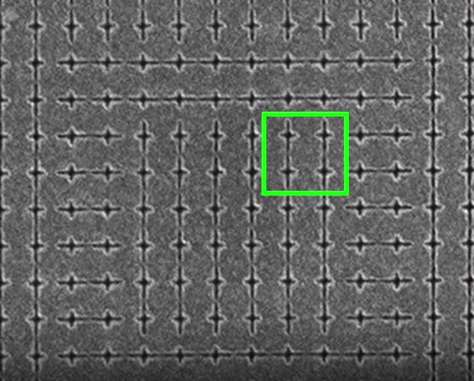Nanoscale printing breakthrough creates two colours per pixel

Scientists have developed a new form of high-resolution 'printing' which could have wide-ranging applications in data storage, anti-counterfeiting measures, and digital imaging.
New research from the University of Glasgow, published today in the journal Advanced Functional Materials, outlines how engineers have developed nano-scale plasmonic colour filters that display different colours depending on the orientation of the light which hits it.
Essentially, this new technique allows the 'printing' of two entirely different, but exceptionally detailed, full-colour images within the same surface area – something which has never been done before using 'structural colour' techniques.
Instead of relying on dyes and pigments, as in traditional printing, structural colour uses specially structured nanomaterials to render colours. The nanomaterials allow for much higher-resolution prints which do not fade over time. A typical printed image in a magazine, for example, might consist of around 300 coloured dots per inch of page, or 300 DPI. A page 'printed' with structural colour techniques, however, could reach a resolution of 100,000 DPI or more.
The University of Glasgow team's breakthrough comes from including an additional nanoscale element in the structural colour process, created at the University's James Watt Nanofabrication Centre.
Biomedical engineering lecturer Dr Alasdair Clark is the lead author of the research paper. Dr Clark said: "We've discovered that if we make colour pixels from tiny cross-shaped indents on a strip of aluminium film, the colour they display becomes polarisation-dependent, allowing us to encode two colours into a single pixel, and then select which colour is displayed by shining different polarisations of light at the surface.
"By changing the size and shape of the nanoscale indent, we can create a wide range of different colours at very high resolutions."
The team, from the University's School of Engineering, have demonstrated their technique with several examples, including a nanoscale image which shows the University's crest when the light reaches it in one orientation, and an image of the famous University tower when the orientation of the light is reversed.
Dr Clark added: "There are a lot of potential applications for our plasmonic colour technology, which we're really excited about.
"It's ideal for long-term data archival due to its ultra-high resolution, and because the colours won't fade even when exposed long-term to the harshest sunlight. We've worked out that we could store 1.46 Gb per square centimetre, so a single A4 sheet could hold more than 900 Gb of data.
"Secondly, the process to produce the plasmonic colours is difficult to replicate without access to dedicated facilities, so it could be ideal for creating a new kind of anti-counterfeiting material for banknotes.
"Lastly, it offers the possibility of developing new types of colour filters for digital photography."
The paper, titled "Plasmonic color filters as dual-state nano-pixels for high density micro-image encoding," is published in Advanced Functional Materials.
More information: Esmaeil Heydari et al. Plasmonic Color Filters as Dual-State Nanopixels for High-Density Microimage Encoding, Advanced Functional Materials (2017). DOI: 10.1002/adfm.201701866
Journal information: Advanced Functional Materials
Provided by University of Glasgow




















